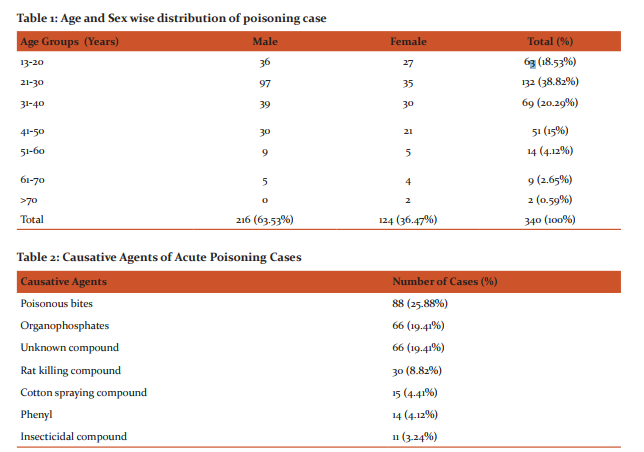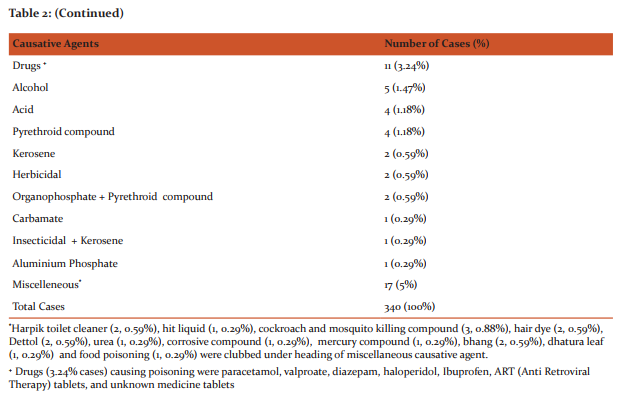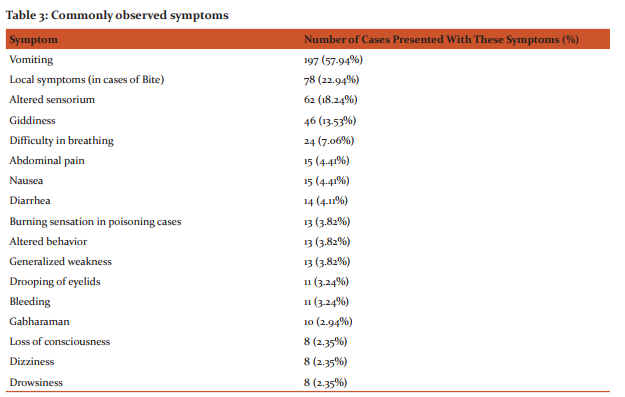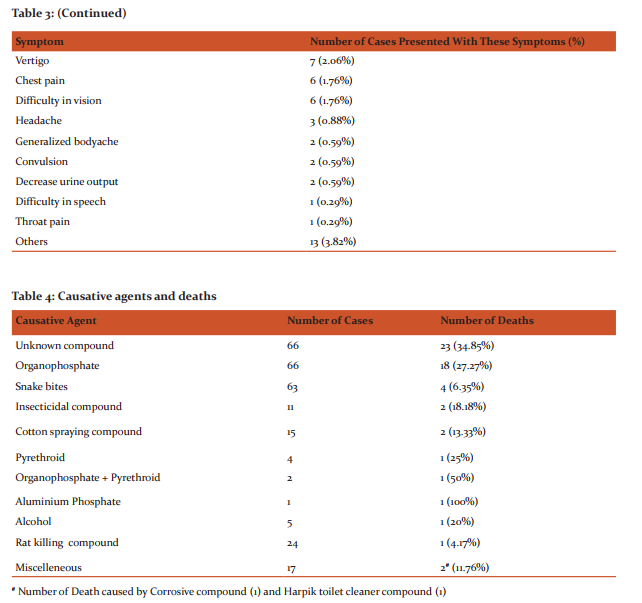IJCRR - 8(13), July, 2016
Pages: 35-41
Date of Publication: 12-Jul-2016
Print Article
Download XML Download PDF
CLINICO-EPIDEMIOLOGICAL PROFILE OF PATIENTS PRESENTING WITH ACUTE POISONING
Author: Shreya M. Shah, Pratik D. Asari, Anand J. Amin
Category: Healthcare
Abstract:Objectives: The present study was conducted with aim to generate the clinico-epidemiological data of Acute Poisoning cases presented at hospital which in turn would be helpful in planning rational use of available resources for prevention and management of poisoning cases.
Methods: Observational cross-sectional study was carried out from October, 2013 to March, 2014. Patients of either sex of above 12 years of age of acute poisoning admitted in medicine emergency ward were included. Obtained data were analyzed using descriptive statistics and results were expressed as percentage and mean.
Results: Of 340 cases, male and female patients were 216(63.53%) and 124(36.47%) respectively. Male: female ratio was 1.74:1. Most of the cases belonged to the age group of 21-30 years (38.82%). Ingestion was the most common route of exposure (71.47%). Intentional (suicidal) poisoning was recorded in 62.06% cases followed by accidental poisoning (37.94%). Common causes of poisoning were poisonous bites (25.88%) followed by organophosphate (19.41%) and unknown compound (19.41%) ingestion. Commonly observed symptoms were vomiting, local symptoms in cases of bites, altered sensorium, giddiness and breathing difficulty. Average number of days of hospitalization was 5.39 days. Complete recovery and mortality were seen in 66.47% and 16.47% cases respectively.
Conclusion: Acute Poisoning is one of the leading causes of hospital admissions and mortalities. High costs of treatment and intensive care burden makes poisoning an important area for further research. The current study has managed to contribute substantial additional information regarding the epidemiology and outcome of poisoning in a tertiary care hospital at a district level.
Keywords: Acute Poisoning, Clinico-epidemiological profile, Medicine emergency, Poisoning
Full Text:
INTRODUCTION
Acute Poisoning is a common medical emergency. Poison is a substance that causes damage or injury to the body and endangers one’s life due to its exposure by means of ingestion, inhalation or contact.1 Acute poisoning due to accidental and suicidal exposure causes significant mortality and morbidity throughout the world.2 According to World Health Organization (WHO) estimates, in 2004, 346,000 people died worldwide from unintentional poisoning of which 91% occurred in developing countries.3 Easy availability of poisonous substances and sparse medical facilities result in a high fatality rate in the developing world. According to recent data from National Crime Bureau of India, accidental poisoning accounted for 17.9% of all causes of un-natural deaths while consuming of poison (26%), was observed for committing suicidal death during the year 2014.4 Acute poisoning cases account for 2-3% of all hospital admissions in India.5 Cases of poisoning are more common in India than the west countries, owing to the ease with which poisons can be obtained, increasing use of chemicals for industrial and domestic purpose, quack remedies containing poisonous drug and frequent occurrences of bites by venomous snakes.6 In India, due to wide geographical variation and vast differences in socio-economic status and cultural practice, the type of poisoning cases encountered in clinical practice differ in different states. So there is a need to collect accurate data on different aspects of acute poisonings. The present study was conducted with aim to generate the clinico-epidemiological data of Acute Poisoning cases pre sented at hospital which in turn would be helpful in planning rational use of available resources for prevention and management of poisoning cases.
MATERIAL AND METHODS
An Observational cross-sectional study was carried out to assess the clinico-epidemiological data of acute poisoning cases admitted in emergency ward of a tertiary care teaching hospital attached to Medical College in Gujarat during October, 2013 to March, 2014. Approval of the institutional ethics committee was obtained before initiating the study. All patients of either sex of acute poisoning admitted in medicine emergency ward, who were above 12 years of age, were included in this study after taking patient’s/ relatives’ verbal consent. Patients of 12 or less than 12 years of age and cases where diagnosis was uncertain were excluded from the study. Data of total 340 acute poisoning cases were collected and were entered in prechecked proforma. These cases were evaluated and observed in the medicine emergency ward, Medical Intensive Care Unit (MICU) and followed up in respective medicine unit wards till their discharge or fatal outcome, as applicable. The data included name and age of the patient, date of admission and discharge, case history, investigations, diagnosis, ongoing treatment and outcome. The data obtained were subsequently analyzed using descriptive statistics and the results were expressed as percentage and mean.
RESULTS
Of 340 cases, male patients were 216 (63.53%) and female patient were 124 (36.47%) with male: female ratio 1.74:1. Most of the cases belonged to the age group of 21-30 years (38.82%) followed by 31-40 years (20.29%) and 13-20 years (18.53%) [Table1]. In this study, the youngest patient was of 15 years of age while the oldest patient was 85 years old. 31.95 + 12.86 years was mean age of all patients. Mean + SD of age of male and female patients were 31.17 + 11.79 years and 33.3 + 14.50 years respectively. Among various routes of exposure for poisons, ingestion was the most common route of exposure (71.47%) followed by dermal (in cases of bites) (25.88%) and inhalation (2.65%). Intentional (Suicidal) poisoning was recorded in 62.06% cases followed by accidental poisoning in 37.94% cases. Out of 340 cases, 25.88% cases were due to poisonous bites which included snake bite, honey bee sting, scorpion bite, nevla bite and unknown bite. Organophosphates and unknown compounds were causative agents in 19.41% cases each. Different causative agents observed during study were as shown in Table 2. Commonly observed symptoms among 340 poisoning cases were as shown in Table 3. Average number of days of hospitalization was 5.39 days per cases. Maximum 38 days of hospitalization was observed in a case of acid compound poisoning. For all patients who were discharged or who died within 24 hours of admission, hospital stay was counted as 1 day [Figure 1]. Complete recovery was seen in 66.47% of cases. Mortality (death) was seen in 16.47% of cases. Other outcomes of poisoning were Discharge against Medical Advice (DAMA) (10.59%), Absconded (5.88%), and Discharge On Request (DOR) (0.59%). Out of 56 death cases, 51 cases were of due to suicidal poisoning and 5 were due to accidental poisoning. Deaths occurred due to different causative agents as shown in Table 4.
DISCUSSION
Of total 340 cases included in this study, male patients were 63.53% and female patients were 36.47% which is similar to findings of B. Maharani et al. (2013) [61.33 % male, 38.63% female] and Peshin SS et al. (1999-2012) [62.19% male, 37.80% female].2,7 Similar male preponderance was seen in other published studies also.8-12 Male preponderance found in the poisoning cases may be because of more exposure to stress in a daily routine life and also because of more occupational hazards than female. However, in few studies, more female patients compared to male patients of poisoning were reported.13, 14 In present study, most of the cases were between 13-40 years of age (77.64%), among which 38.82% patients belonged to 21-30 years of age group. Srivastava A et al.(2005) in their study observed highest incidence of acute poisoning in 14-40 years of age group.15 In a study done in Yavatmal, Vaidya and Hulke et al. (2012) reported maximum poisoning cases in 21-30 years age group (34.50%) followed by 24.53% cases in 31-40 years and 23.23% cases in 11-20 years age group.14 Similar trend of age group distribution of poisoning cases was reported in different studies carried out in Nepal, Sri Lanka and Uganda.14 This trend of highest number of cases in 21-40 years of age group is due to more work pressure, family problems, economical stress and other life settlement problems in this age group.
Ingestion was the most common route of exposure (71.47%) followed by dermal and inhalation. Dermal exposure was seen only in cases of poisonous bites in present study. Similar pattern of route of exposure was reported in study by Srivastava A et al. (2005)15 [88% oral route] and also in other studies.2, 16, 17
Intentional (Suicidal) poisoning was recorded in 62.06% cases followed by accidental poisoning (37.94%). Ramesha KN et al. reported 78% patients of intentional poisoning and 22% patients of accidental poisoning.18 Result of data analysis of poisoning cases reported to the National Poisons Information Centre, New Delhi showed that nearly half (47%) of poisoning cases were accidental (1-70 age group).15 Accidental poisoning is more common in pediatric age group which we have excluded from this study. This may be a possible reason for less accidental poisoning cases in present study compared to national data for India in which cases of all age groups were reported. Out of 216 male patients intentional poisoning was observed in 67.12% male patients; while for female patients, it was 53.22%. Intentional poisoning was more in males in present study. This finding was similar with other studies done by Sharma et.al(2002), Dash et al. (2005) and Singh et al. (1984) but contradicts the study done by Pokhrel et al.(2008) in which incidence was high among females.2 While analyzing data for causative agents for poisoning, we found that 1/4th (25.88%) of all cases were due to poisonous bites and 19.41% cases were of Organophosphate poisoning, which is parallel to findings of the study by Banerjee I et al. (31.90% snake bite, 21.84% organophosphorus compounds).13 In the study conducted by Ramesha KN et al., majority of poisoning cases were due to OP compounds (36%) followed by snake bite in 16.2%.18 In studies carried out at different centers in South India, organophosphate compounds were found to be the commonest causative agents for poisoning, while the incidence of aluminium phosphide poisoning was found to be high in North Indian studies.2 Higher incidence of snake bite cases in present study can be because of geographical location of our tertiary care hospital where snake bite incidence is high. Another possibility for this can be the fact that the study period was harvesting season. Providing symptomatic and specific antidote treatment and supportive care for the patient was the mainstay of management in the majority of poisoning cases observed during study. Days of hospitalization in present study ranged from 1 to 38 days with an average of 5.39 days per patient. In the study conducted by Vaidya and Hulke et al., observed duration of hospital stay varied from 1 to 5 days.14 Mortality (death) was recorded in 16.47% of patients. In studies by Vaidya and Hulke et al., Ramesha KN et al. and Singh S et al. overall mortality were found to be 20%, 15.4% and 17.3% respectively.14, 18, 19 Incidence of death as high as 16.47% observed in this study can be result of one or more factors operating in individual patients like time lapsed between consumption of poison and hospital admission and lake of information of the poison consumed/ingested. Many patients were referred from private hospital when their conditions became worse. Recovery in 2/3rd of patients (66.47%) is a result of good emergency and intensive care management at our hospital set up. Few of the limitations of the present study were poor documentation of data mainly because of scarcity of better trained staff and exclusion of poisoning cases in children less than 13 years age. Also, as the study was conducted at a single hospital for a short duration, results cannot be generalized.
CONCLUSION
Acute Poisoning is one of the leading causes of hospital admissions and mortalities. High costs of treatment and intensive care burden makes poisoning an important area for further research. The current study has managed to contribute substantial additional information regarding the epidemiology and outcome of poisoning in a tertiary care hospital at a district level. Educational programs with emphasis on preventive measures are necessary to create awareness among the general public.
ACKNOWLEDGMENT
Authors acknowledge the immense help received from the scholars whose articles are cited and included in references of this manuscript. The authors are also grateful to authors / editors / publishers of all those articles, journals and books from where the literature for this article has been reviewed and discussed. Funding and support: None. Conflict of interest: None.
References:
1. Thomas W F, John H D, Willium R H. Stedman’s medical dictionary. 28th edition. Lippincott William and wikins, Newyork. (2007)2004.
2. B. Maharani and N. Vijayakumari., Profile of poisoning cases in a Tertiary care Hospital, Tamil Nadu, India. J App Pharm Sci. 2013; 3 (01): 091-094.
3. World Health Organisation. International Programme on Chemical Safety. Poisoning prevention and management. Available from: http://www.who.int/ipcs/poisons/en.
4. New Delhi: National Crime Records Bureau Ministry of Affairs; 2014. Accidental Deaths and Suicides in India 2014. Available from: http://ncrb.nic.in/ADSI2014/adsi-2014%20full%20report.pdf
5. Chadha IA. Poisoning. Indian J Anaesthesia 2003;47(5):402- 411.
6. Subrahmanyam BV. Poisons and there medico legal aspects. In: Modi’s Medical Jurisprudence and Toxicology. 22nd edition. New Delhi: Lexis Nexis Butterworth Tripathi Publication; 2002. edition New Delhi :48 Peshin SS, Srivastava A, Halder N, Gupta YK. Pesticide poisoning trend analysis of 13 years: a retrospective study based on telephone calls at the National Poisons Information Centre, All India Institute of Medical Sciences, New Delhi. J Forensic Leg Med. 2014 Feb;22:57-61
7. Lall, S.B., S.S. Al-Wahaibi, M.M. Al-Riyami and K. Al-Kharusi, 2003. Profile of acute cases presenting to health centres and hospital in Oman. Eastern Mediterranean Health J., 9:944-954.
8. Kanchan, T. and R.G. Menezes, 2008. Suicidal poisoning mortalities in southern India: gender differences. J. Forensic, Leg. Med., 15:7-14.
9. Al-Barraq, A. and F.Farahat, 2011. Pattern and determinants of poisoning in a teaching hospital in Riyadh, Saudi Arabia. Saudi Pharma. J.,19:57:63.
10. Rajanandh M. G., Santhosh S., Ramasamy C. Proospective Analysis of Poisoning Cases in a Super Speciality Hospital in India. Journal of Pharmacology and Toxicology.2013;8(2):60-66.
11. Rajanandh M. G., Santhosh S. Retrospective Assessment of Poisoning Cases in a Multi Specialty Hospital in Tamilnadu. Journal of Pharmacology and Toxicology. 2014;9(2):105-109.
12. Banerjee I, Tripathi SK, Roy AS. Clinico-epidemiological profile of poisoned patients in emergency department: A two and half year’s single hospital experience. Nt J Crit Illn Inj Sci. 2014 Jan-Mar; 4(1): 14–17.
13. Vaidya YP, Hulke SM. Study of trends of poisoning in the cases reported to government hospital, Yavatmal. Chron Young Sci 2012;3:63-7.
14. Srivastava A, Peshin SS, Kaleekal T, Gupta SK. An epidemiological study of poisoning cases reported to the National Poisons Information Centre, All India Institute of Medical Sciences, New Delhi. Hum Exp Toxicol. Jun 2005;24(6):279-85.
15. Jesslin j, R. Adepu, S churi. Assessment and Prevalence and mortality incidences due to poisoning in south indian tertiary care hospital. Indian J. Pharm sci.2010;72;5,587-591.
16. Anthony L, Kulkarni C. Patterns of poisoning and drug overdosage and their outcome among in-patients admitted to the emergency medicine department of a tertiary care hospital. Indian J Criti Care Med 2012; 16: 130-5.
17. Ramesha K.N., Krishnamurthy B. H. Rao, Ganesh S. Kumar. Pattern and outcome of acute poisoning cases in a tertiary care hospital in Karnataka, India. Indian J Crit Care Med. July-September 2009 ;13(3):152-155.
18. Singh S, Shama B K, Wahi P L, Anand B S, Chugh K S. Spectrum of acute poisoning in adults(10 year experiences). Journal Assoc. Physician India. 1984; 32: 561-563





|






 This work is licensed under a Creative Commons Attribution-NonCommercial 4.0 International License
This work is licensed under a Creative Commons Attribution-NonCommercial 4.0 International License